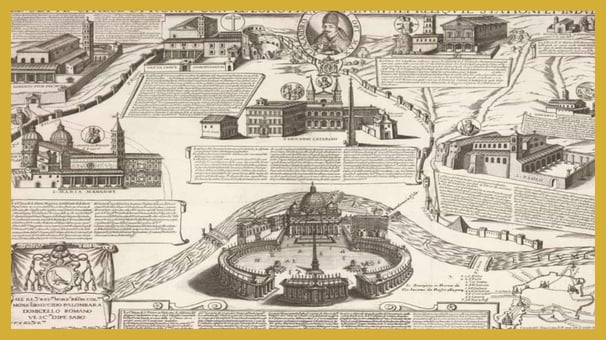The Seven Churches Pilgrimage: A Faith Journey in Rome during the 2025 Jubilee
Contents
History and Origins of the Seven Churches Pilgrimage
St. Peter's Basilica
Basilica of St. Paul Outside the Walls
Basilica of St. Sebastian Outside the Walls
Basilica of St. John Lateran
Basilica of the Holy Cross in Jerusalem
Basilica of San Lawrence Outside the Walls
Basilica of St. Mary Major
Conclusion
The Seven Churches Pilgrimage, one of Rome’s oldest and most captivating pilgrimages, was envisioned by Saint Philip Neri in the 16th century. It spans approximately 25 kilometers throughout the Eternal City, linking several of Christianity's most significant basilicas. This pilgrimage, still actively followed by numerous pilgrims today, becomes especially meaningful during the 2025 Jubilee , where tradition merges with the deep spirituality of the Jubilee journey. The churches along this route not only connect visitors to the Church's history but also provide a chance to delve into the quietude of prayer and spiritual reflection.


History and Origins of the Seven Churches Pilgrimage
The Seven Churches Pilgrimage originated in 16th century Rome, initiated by Saint Philip Neri. On February 25, 1552, amid the Roman carnival's exuberant revelries, Saint Philip Neri organized a devotional procession with his followers and the congregants of the Church of San Girolamo. This event marked the formal inception of the Pilgrimage of the Seven Churches, which rapidly became a profound demonstration of Christian life in Rome.
The path drew inspiration from the ancient tradition of medieval pilgrimages to Rome’s sacred sites, notably the basilicas and catacombs. Saint Philip Neri uniquely blended meditation with joy and light-heartedness, transforming the pilgrimage into a profoundly joyous spiritual encounter.
The primary aim of the Seven Churches Pilgrimage was to present a Christian alternative to the carnival festivities, offering a journey of faith and prayer. Participants, grouped together, visited seven major Roman basilicas to pray, reflect, and chant sacred hymns. Throughout their journey, they paused at pivotal Christian historical sites to meditate on the lives of the saints and the Passion of Christ.
The selection of seven churches was deliberate. In the Bible, the number seven symbolizes the union between heaven and earth, perfection, and fullness, representing the days of Creation, the gifts of the Holy Spirit, the sacraments, and the works of mercy.
Over the centuries, the Seven Churches Pilgrimage has attracted popes, saints, artists, and ordinary people alike, making it a highly celebrated event in Rome. Following Saint Philip Neri's death, the tradition continued under the stewardship of the Congregation of the Oratory. Despite occasional disruptions due to wars and epidemics, the Pilgrimage has endured, underscoring its importance in the spiritual lives of Christians.
St. Peter's Basilica
St. Peter’s Basilica is the spiritual heart of the Jubilee and the Seven Church Pilgrimage. Its Holy Door symbolizes divine mercy and serves as the perfect starting point for every pilgrim. With its majestic dome designed by Michelangelo and the tomb of the Apostle Peter, St. Peter’s stands as the spiritual center of Christianity. Crossing the threshold of the Holy Door is a profound experience of reconciliation and prayer for those who make the journey.
Basilica of St. Paul Outside the Walls
One of the largest churches in Rome, the Basilica of St. Paul Outside the Walls was built over the tomb of the Apostle Paul. Stepping through its Holy Door is a symbolic act of embracing the teachings of St. Paul, the Apostle to the Gentiles, who dedicated his life to spreading the Gospel. This pilgrimage stop is particularly meaningful for those reflecting on the themes of mission and evangelization.
Basilica of St. Sebastian Outside the Walls
The Basilica of St. Sebastian Outside the Walls is dedicated to the soldier who was martyred during the persecutions of Emperor Diocletian. For centuries, this site has been a destination for pilgrims, partly due to its catacombs, which once housed the relics of the Apostles Peter and Paul. The basilica remains a powerful place of devotion, inviting the faithful to meditate on martyrdom and the courage of faith.
Basilica of St. John Lateran
Known as the "Cathedral of Rome," the Basilica of St. John Lateran is the official seat of the Bishop of Rome—the Pope. It is the oldest of the four papal basilicas and has a Holy Door that welcomes pilgrims on their journey of conversion. For centuries, St. John Lateran has been the center of ecclesiastical life and continues to be a symbol of unity within the Church.
Basilica of the Holy Cross in Jerusalem
The Basilica of the Holy Cross in Jerusalem holds some of the most significant relics of Christ’s Passion, including fragments of the True Cross. Founded by St. Helena, the mother of Emperor Constantine, this basilica is a deeply spiritual place where pilgrims can reflect on the meaning of the Cross and Christ’s sacrifice.
Basilica of San Lawrence Outside the Walls
Erected at the site of Deacon St. Lawrence's martyrdom, the Basilica of St. Lawrence Outside the Walls commemorates one of the most revered saints of the Catholic Church. During the Seven Churches Pilgrimage, this stop encourages pilgrims to contemplate faith's sacrifice and service, inspired by St. Lawrence’s bravery during Emperor Valerian’s persecutions.
Basilica of St. Mary Major
Marking the conclusion of the Seven Churches Pilgrimage, St. Mary Major Basilica, dedicated to the Virgin Mary, ranks among the foremost Marian shrines worldwide. Its Holy Door beckons pilgrims to seek the intercession and protection of the Mother of God. Renowned for its stunning architecture and its ties to miraculous occurrences like the dream that prompted Pope Liberius to initiate its construction in the 4th century, St. Mary Major endures as a beacon of devotion and heritage.
Conclusion
The Seven Churches Pilgrimage is not only a physical journey but also a genuine path of spiritual growth. Each basilica, with its history and unique significance, offers an opportunity to encounter divine grace and mercy. Undertaking this pilgrimage route during the 2025 Jubilee allows pilgrims to rediscover the value of prayer, penance, and conversion.
Should you wish to delve deeper into the history and spirituality of each of these basilicas, consider exploring the dedicated articles that examine every aspect of these sacred places and their role in the Holy Year
Drop us a line
Follow us
Discover the Jubilee
Experience the Jubilee
Jubilee locations
Get ready for the Jubilee
Rome and the Jubilee
